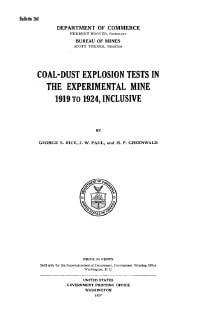Mining Publication: Coal-Dust Explosion Tests in the Experimental Mine 1919 to 1924, Inclusive
Original creation date: January 1927
Authors: GS Rice, JW Paul, HP Greenwald
NIOSHTIC2 Number: 20037439
Pittsburgh, PA: U.S. Department of Commerce, Bureau of Mines, Bulletin 268, 1927 Jan; :1-176
This paper reports US Bureau of Mines (USBM) research on the explosibility of coal dusts. The purpose of this work is to improve safety in mining and other industries that process or use coal. Most of the tests were conducted in the USBM 20 litre laboratory explosibility chamber. The laboratory data show relatively good agreement with those from full-scale experimental mine tests. The parameters measured included minimum explosible concentrations, maximum explosion pressures, maximum rates of pressure rise, minimum oxygen concentrations, and amounts of limestone rock dust required to inert the coals. The effects of coal volatility and particle size were evaluated, and particle size was determined to be at least as important as volatility in determining the explosion hazard. For all coals tested, the finest sizes were the most hazardous. The coal dust explosibility data are compared to those of other hydrocarbons, such as polyethylene dust and methane gas, in an attempt to understand better the basics of coal combustion.

NIOSHTIC2 Number: 20037439
Pittsburgh, PA: U.S. Department of Commerce, Bureau of Mines, Bulletin 268, 1927 Jan; :1-176
- A Centennial of Mine Explosion Prevention Research
- Coal Dust Explosibility
- Evaluation of the Bagged Stone Dust Barrier Effectiveness in a Bord and Pillar Mine
- The Explosibility of Coal Dust
- First Series of Coal-Dust Explosion Tests in the Experimental Mine
- How Does Limestone Rock Dust Prevent Coal Dust Explosions in Coal Mines?
- Mitigating Coal Dust Explosions in Modern Underground Coal Mines
- Observations of Post-Explosion Dust Samples From an Experimental Mine
- Rock Dusting Considerations in Underground Coal Mines
- Technology News 515 - Float Coal Dust Explosion Hazards